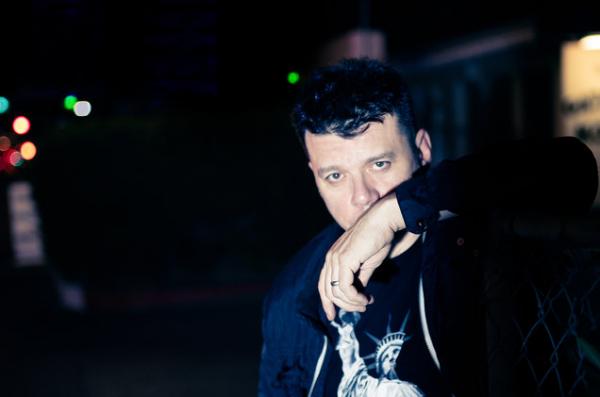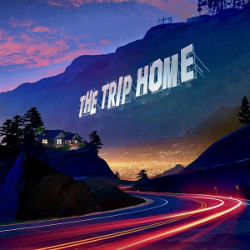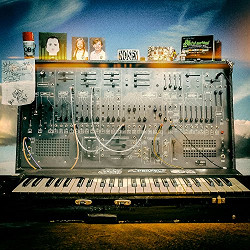Scott Kirkland Reboots The Crystal Method

Going it alone is never easy, especially after reaping so many sonic rewards from a long and fruitful creative partnership. Yet that’s exactly what Scott Kirkland did when Ken Jordan, his longtime partner in the pioneering electronic duo known as The Crystal Method, recently announced his retirement from active musical duty. Undeterred, Kirkland rebooted TCM 2.0 mostly on his own (albeit with a little help from a few collaborative friends) for the aptly titled The Trip Home (Tiny E Records).
“Well, it’s more like 1.5,” Kirkland observes with a laugh. “But it is interesting moving forward after working with one collaborator for so many years, but Ken is happily retired. He’s quite done, and he’s quite happy with what he’s moved on to. He’s actually become a fan, and he always remains someone I can reach out to for advice. I’m not burdened with any baggage that may come with any kind of separation. There was no animosity built into it, or any in-fighting. We had one opportunity to hang out in the middle of the recording process, and he gave me some great feedback.”
Kirkland, 48, got on the line with me from his studio locale in California to discuss getting back to his core electronic music values, his thoughts about remixing new and catalog material in Dolby Atmos, and refocusing his goals following brain surgery.
 Mike Mettler: Last time you and I talked [in March 2015], we talked a lot about surround sound — which we’ll get back to in a moment — but as I continue to listen to The Trip Home in stereo, it sounds to me like you captured a really wide soundstage to the point where I sometimes feel like things are moving beyond my front speakers. Was that a goal for you in terms of the overall sound design?
Mike Mettler: Last time you and I talked [in March 2015], we talked a lot about surround sound — which we’ll get back to in a moment — but as I continue to listen to The Trip Home in stereo, it sounds to me like you captured a really wide soundstage to the point where I sometimes feel like things are moving beyond my front speakers. Was that a goal for you in terms of the overall sound design?
Scott Kirkland: Yeah, it was, for sure. I was mixing it through a Neve board. I went to Sound City, which is now being run with the help of a producer-friend of mine, Tony Berg, whom I’ve known for many, many years. [Berg has produced artists like Edie Brickell, PiL, and Aimee Mann.] One of the strange, serendipitous facts behind all this was that Tony was the guy who hired Ken [Jordan] to come out from Las Vegas to Los Angeles in the late-’80s/early-’90s.
They brought a new Neve board into Sound City, and I was lucky enough to mix the new record on it. And I’ve always found that being able to run more digital kinds of things through a board like that one really expands the stereo field.
Also, I didn’t want to clutter things up too much this time. On the last album [2014’s The Crystal Method], things got a little over-baked, the overall process maybe took too long, and maybe there was too much of an effort to keep up with the Joneses a little bit and we were living too much in that EDM world. So, this is more of my anti-EDM album, if you will. I wasn’t worried about any kind of algorithms and those more recent kinds of things artists living in the world of Spotify have to do: “You don’t want any skips, so make sure you hit the chorus by this time, and don’t have too many tails on things.” I just rebelled against all of that a bit.
I really wanted to make an album that was cinematic, had a bit of a narrative, and told a story. I felt there was an opportunity here to make something special and reflect on the 20-plus years of the band and where we had come. And this is the first step for the next few years of the band. The evolution is here, and I’m embracing it and enjoying the process.
Mettler: To borrow a phrase from one of The Trip Home’s song titles, I’d say, “Holy Arp.” I also really love the image you chose to go with the digital single version of that song. It’s a beautiful thing.
Kirkland: Yeah, and that was the image I was basically looking at. When Ken retired, I converted the studio over to my needs, and I brought in some of my favorite gear that’s really close to me. And that ARP 2600 [analog synthesizer] and its companion sequencer were quite inspiring, to say the least.
 Mettler: People will know that ARP sound for its classic 1970s feel. Was any of that in your mind when you brought that gear out to play?
Mettler: People will know that ARP sound for its classic 1970s feel. Was any of that in your mind when you brought that gear out to play?
Kirkland: Well, I’ve always been a fan of the fact that the R2-D2 sounds were created on the ARP 2600. And I felt that if the ARP could make a droid emote, it would be a good instrument to break through. One of the things I think is difficult about music these days is that everything is so perfect. There are a handful of producers producing all of these songs for all these artists, and it’s really hard to define one artist from another artist.
There are a couple of moments in “Holy Arp” where you get this shuffle beat, and you also get that extended heartbeat from the ARP 2600. It’s such a unique instrument, and I’ve really enjoyed going back into the studio and reacquainting myself with this gear that’s literally sitting a few feet away from me here in the studio, just waiting to be turned back on to make some noise.
Mettler: You’re often an analog man in a digital world, in a manner of speaking.
Kirkland: Yeah, and I did find that with the relationship I have with the gear that’s in the studio like the Memorymoog and the [Roland] Jupiter-6, the synths that are on the early albums.
Mettler: This really is a trip home, then, if you’re doing a full circle return to your recording roots, yet still moving forward. That, of course, makes me think you need to do a 360-degree surround mix of this new material, wouldn’t you agree?
Kirkland: Oh yeah. Recently in Chicago, I played at Sound-Bar, which has the [Dolby] Atmos system in it, and I’ve been talking about going in and doing an Atmos mix of The Trip Home.
Mettler: Oh, I love that idea, so I’m officially marking down The Trip Home for a full-on Atmos mix.
Kirkland: (laughs) I’m playing a show in San Francisco near where Atmos is based, and then I’ll have a chance to talk to them about it, and maybe doing something with Atmos for my future releases.
Mettler: Please do. You’ve got the building blocks here to literally put us in the Crystal Planetarium.
Kirkland: (laughs) Yeah, I like it, I like it! That’s a good title for it.
Mettler: One Trip Home song that immediately comes to mind as being perfect for a 5.1 mix is “Turbulence.” There’s a literal tsunami of sound on that track, with such a great sense of space around it.
Kirkland: (laughs heartily) Yeah! It’s like a thousand hornets in the belly of a spaceship, and when it breaks free of the earth’s gravity, you have that drop where there’s all that space, where it feels like you’re floating in it.
You know, I really, really enjoyed the process of making The Trip Home and the collaborators and co-conspirators I had on it. I’m really happy with how it resets the band going forward.
Mettler: And speaking of resetting, you took an interesting tack on “There’s a Difference” by turning the dial a little bit on a track that was also on the 2014 record, The Crystal Method.
Kirkland: I don’t mean to belabor the point, but the 2014 record was such a unique experience for us because we were in the middle of this giant EDM bubble. It felt like we were running this sort of small fishing expedition up this pristine coast of California, and all of a sudden, this giant cruise ship of EDM came to port. And for some reason, we felt like we had to compete or live in that world to be able to survive, and that record represents a little bit of that. Plus, it was also interrupted by my brain surgery. [Kirkland had brain surgery to remove a cyst in April 2013, surgery from which he’s long since fully recovered.]
But Franky [Perez, vocalist on “There’s a Difference”] is remarkable, and his performance on it is wonderful. The first lyrics on that track just lend themselves to this idea of change: “You think you know what’s going to be/but listen, baby, carefully.” It begs to be re-interpreted in a way, and I really enjoyed bringing that song forward.
Mettler: As we know, songs evolve over time anyway. That also makes me think of the surround version you guys did for the [2004] Legion of Boom song “Weapons of Mass Distortion,” which gave it an additional dimension or two.
Kirkland: Oh yeah yeah yeah, on the DTS version of that one — I’ve got to break that one out!
Mettler: I enjoyed revisiting that album recently on DVD-Audio, I have to tell you. And that was all done at 48/24, right?
Kirkland: I have mainly just lived in a 48/24 world, yeah.
Mettler: The bit rate is really the crux of the matter anyway, isn’t it? The depth of scope on a Trip Home track like “Cabin Pressure” certainly bears that out.
Kirkland: You’re right. That was an interesting track because I started with Matt Lange, a very talented electronic artist. He has a Eurorack [modular system], and it was really interesting working within what he had dialed into that setup. We both had the idea of having Justin [Chancellor, of Tool] play some bass on it. I sent the track to him, and he did this late-night kind of session where he was freestyling over the top of what was there.
I’ve always welcomed the idea of bringing different artists from different backgrounds in, like your pointing out what we did on “Weapons of Mass Distortion” and our working with [Limp Bizkit guitarist] Wes Borland, or on the [2001] Tweekend album working with Tom Morello and Scott Weiland, and all the people we’ve been fortunate to work with over the years. I like introducing those different elements and then bringing it all together. Sometimes it’s like being a chef working with different ingredients.
Mettler: A literal “bouillabaisse” of sound, if you will. (Kirkland laughs) Speaking to your collaborative sense, I think what was done on “Ghost in the City” is a great example of you being the chef and bringing out the best in Amy Kirkpatrick’s vocal, plus the overall harmonies and sense of space.
Kirkland: Yeah, and we changed a couple of lines in the lyrics, because it initially came over from Dylan [Eiland, the Atlanta-based DJ a.k.a. Le Castle Vania] and Amy as a 16- or 24-bar intro, and I wanted to explore the idea of this lost, sympathetic innocent who finds out that one moment she’s alive, and the next moment, she’s no longer with us. That sense of forgetting, and the anger and the loss or being excluded — literally, the sense of being lost. At the end of it, I had a great deal of fun just exploring space.
Mettler: It sounds like she’s underwater, or even being buried, at the end of it.
Kirkland: Yeah, that’s it — almost like she’s being evaporated into the atmosphere. She’s sort of dissolving before our ears as the distance becomes further. And then that drops down, and we get “Turbulence” coming in there next.
Mettler: I really had to grip the arms of my chair during that one-two sonic punch. Is that you repeating the line there that goes, “The journey that begins where everything ends”?
Kirkland: That was taken from some movie trailer we found online, from many years back. There are many different ways of saying that. That one may be the most ambiguous, but I really like the idea of — especially being halfway through the album — that any journey worth taking has a finish line. It has an ending that you know is before you, and you want to make sure you enjoy the process of those trips that you take over the years with your family or your friends or even on your own. You only have so much time with which to enjoy yourself and make the most of it.
By having a finish line, or knowing there’s an end at some point that’s ahead of you — for me, I love the idea of living the moment and being in the moment. It really represented to me this idea of making the most of every opportunity and having fun, and not letting any opportunity go by or have any wasted moments of time.
Mettler: Considering what you went through a few years ago with and after your brain surgery, that’s wholly understandable. Before we wrap this up, can I get you to commit to doing those Atmos mixes we’ve been talking about?
Kirkland: I’m seriously considering it, and I’m also thinking of opening up the catalog and going into some of the other albums and put them through the Atmos experience.
Mettler: How about you take the really cool Deadmau5 remix of “Cherry Twist” [a classic track from TCM’s 1997 debut album Vegas] and work that one up in 5.1?
Kirkland: Yes, absolutely, I like that idea! I’ve been thinking about this, and it may happen for the 25th anniversary of Vegas [in 2022] — we were thinking of doing an orchestral version of that album, and also do it for some kind of special show.
Mettler: Nice. You could even perform it at Red Rocks with the Colorado Symphony.
Kirkland: You’re speaking my language — I love it! I definitely want to carve out the time to do that. Again, The Trip Home has really allowed me to establish the new sound, and also show there’s someone behind this project who really cares about where I’ve come from, and being part of that scene where things really kicked off for us.
I’m really excited about the future. The next album will be called The Trip Out, which I’m looking forward to have come out next year. Then I’ll tour it live next year, and then come back to maybe do some festivals in 2020. I’ll be turning 50, so who knows where I’ll be after that? I’ll be the same enthusiastic wide-eyed music fan that I am today.





























































